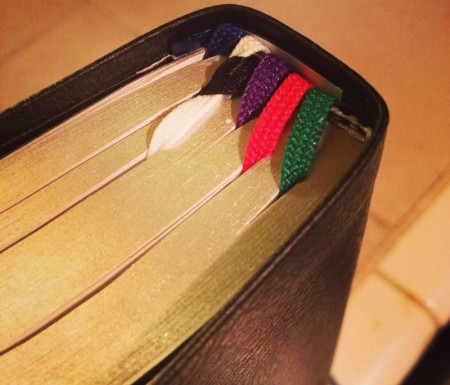
We must love them both, those with whom we agree, and those with whom we disagree. For both have labored in the search of truth, and both have helped in the finding of it.
~ Saint Thomas Aquinas
Like peas and carrots, The United Methodist Church is better together.
At coffeeshops in Seattle, I tell curious atheists about our unique recipe: The UMC is a global, mainline, evangelical Church. We sit at the intersection between evangelical (baptists, etc.) and mainline (the Seven Sisters of Protestantism ) traditions, drawing the best elements from them both. Progressives and conservatives live together under a global democratic representative polity, accountable to our episcopal governance.
We are the largest denomination in America that affirms the full inclusion of women (women’s ordination), and our global structures are unmatched in the ways they advocate, educate, and sustain our witness to Christ’s love for the world. In a polarized Fox News or MSNBC either/or world, peas and carrots together offers better nourishment for our common life together.
We have weathered the “hot topic” storms before. We affirmed women’s ordination, we affirmed appointing African-American clergy to white parishes, and vice versa. We came to a middle ground on reproductive choice, and we sustained a social witness against Apartheid in Africa and ethnic cleansing. Peas and carrots together!
But there’s a bad taste in our mouth now at the potluck dinners when it comes to LGBTQ inclusion and exclusion. Why?

The Bad News
Sadly, a sizable segment of the conservative wing (the “Traditionalists”) has been following leadership that has not been operating in good faith. Since 2004 (see the document here), renewal group leadership has been seeking a future of separation, not unity. Indeed, a recently-resurfaced strategy document (see the document here) laments that anything less than a takeover would “leave the United Methodist denomination somewhat intact.”
The result is that many of the options to be debated (The Traditional Plan, the Connectional Conferences Plan, and the Plan of Dissolution/Reformation as the Wesleyan Covenant Association) were predicted and labored to be the only options on the table. This explains the dogged support of the Traditional Plan, despite large sections of it being declared unconstitutional, and independently-verified concerns on how it affects clergy pension benefit improvements.
This Good News document represents five different strategies to implement one clear vision: “certainty and uniformity within the UMC.” The authors believe that uniformity can be achieved only by separation. We are, in other words, better off if we are separate than if we are together. We are close to closing up the big tent Methodism that we and our grandparents have enjoyed and sustained, and given our political climate, never again would peas and carrots be served together.

The Good News
The real Good News is that we have a tried and true alternative on the table, however imperfect. We have tried the One Church Plan before—and it found success.
The predecessor to the OCP was formed in response to care for divorced persons. From the 1850s to the 1930s, the various bodies of Methodism were hardline against divorce, calling it “consecutive polygamy.” But as Dr. Darryl Stephens, director of UM studies at Lancaster Theological Seminary, notes:
“At the uniting conference of 1939, Methodists revised church law to allow more room for case-by-case discernment. Exercising pastoral discretion meant that annual conferences and local churches were freer to respond to the needs of the individuals in their care.
By 1960, General Conference had turned regulation of divorce over to regional and local bodies of the church. And by 1972…The United Methodist Church had adopted the statement, “we recognize divorce and the right of divorced persons to remarry.”
By living into Wesleyan regional accountability, the Church was held together. While we still struggle with the practical inclusion of women, persons of color, and those who experienced abortions or divorce, we do so at a common table, not siloed away with peas and carrots at opposite ends of the potluck line, never the twain to meet.
The future is uncertain whether stronger regional accountability will lead to full inclusion: our history is checkered on that point. But given that we have a common history together bodes well for a common future together, whatever it may look like.

A Word from Scripture: Ruth and Orpah against Amicable Separation.
Finally, there are several efforts to create easy exit ramps and amicable separation to separate the peas and carrots. But Scripture again and again shows that the story of God’s beloved people is a story of reconciliation, not separation. Over and over the Hebrew people are reconciled back with God and with the people.
Indeed, one story of “amicable separation” is found in the first chapter of Ruth—and it ends up being a cautionary tale. Naomi has two daughters-in-law Ruth and Orpah. All their husbands die on a journey and they are alone. Naomi tells the daughters to go back home and to leave her. Orpah chooses to amicably separate and returns home. Ruth remains with Naomi and pledges that “where you go, I will go.”
Ruth goes on to become part of the bloodline from Abraham to David to Jesus in Matthew’s chronology. But even more interesting is what happens to Orpah. The canonical scriptures are silent but a Jewish midrash claims that Orpah returns home and becomes the parent of…Goliath. Goliath who fights with David, a descendent of Ruth! So the two children of the amicably separated family perpetuate the violence done to them down the familial lines. Fascinating!
The thought of children continuing parental conflicts affects me deeply. My wife and I have three daughters under age 7. Yes, it’s a busy household! But when I rock them to sleep and imagine their futures, I want my generation to be the last that has been broken by the debate over LGBTQ exclusion. I want a church committed to relentlessly loving them no matter who they become, and will seek unity, not because it’s expedient but because it’s difficult and ultimately faithful. My daughters, and your children and grandchildren, deserve better than what we have afflicted on children and youth.
Final Word
“We can disagree and still love each other, unless your disagreement is rooted in my oppression and denial of my humanity and right to exist.”
Like the cliche reads, you need a left wing and a right wing to fly. And if we want the United Methodist Church to soar, then holding unity in diversity (not uniformity) is a powerful witness to a culture all too ready to ghettoize the world. To be better together requires the removal of polity and practices that too easily lead to the fears in the quote above.
Both the One Church Plan and the Simple Plan remove the harmful language and set us on a common course together, and rebuke the unbiblical beliefs that diversity is a sin and “minority mania” is a cancer that should be cut out. We are better together and can continue together under both plans that seek a more just unity rather than separation.
The choice is yours. But as for me, pass the peas and carrots together, can you please?
Prayers for you and yours as we enter the winter of discontent and find the Spirit’s path for us together.
Your Turn
Thoughts?
Thanks for reading, commenting, and sharing on social media and with the GC delegate you are most connected to.


Thank you for your reporting. I believe, as you do, in one United church, we are UNITED Methodists after all!
Jeremy, Another excellent piece. I concur with your assessment that the real argument from the beginning of the church has been about uniformity because diverse experiences of God by diverse persons in the church were the reality. We are better together and stronger, too. Thanks. See you in St Louis.
One of the best blogposts I’ve yet read here, and that’s saying something! Thanks, Jeremy.
I had begun to suspect that the traditionalists were not acting in good faith. I believe that God will cry if we divide. We are better as one even when we disagree. This issue is NOT fundamental to our faith. Christ calls us to love each other, I don’t remember Him saying”except”. Just do it!
Thanks for writing for the challenges the United Methodist has faced over the years. Our reaction to social change has been one of embracing diversity and finding a way to remain as one denomination. The two questions that matter and we need to ask ourselves are: Are we followers of Jesus? Are we permitted to voice diverse opinions and still respect one another?
1844. The Methodist Church schismed (is that even a word???) over slavery. 1939 – the schismed (I’m going with it) came back together. No matter what happens, even if the church splits down the middle and goes two ways, God can bring us together again. I know what I want to see out of this Conference, and I’m not sure it’s what I will see, but I’m trying to remain hopeful that, whether we remain United in our differences or have to find ourselves reUnited sometime in the future, God’s will ultimately be done. In the meantime…I will continue to pray, “God, make me an instrument of Your peace…”
Jeremy,
Thank you for saying so well what is on the hearts of so many.
Jan
Well, as far as achieving “uniformity” through separation, I have bad news for the good news folks: you can silo yourselves off all you like, but you will not be able to keep LGBTQ+ people out. They will *still* be the little guy who is a different in your kids program, or the teenager in youth group trying to figure out why you hate him so much. They will still be the man or the woman in a mixed orientation marriage and trying do everything “right,” but still crippled by the weight of shame because “committing sin in your heart is the same as acting on it.” They will still be the “sisters” and “roommates” who put up with your crap because they love Jesus and the church THAT MUCH.
So, sorry not sorry. We aren’t going away.